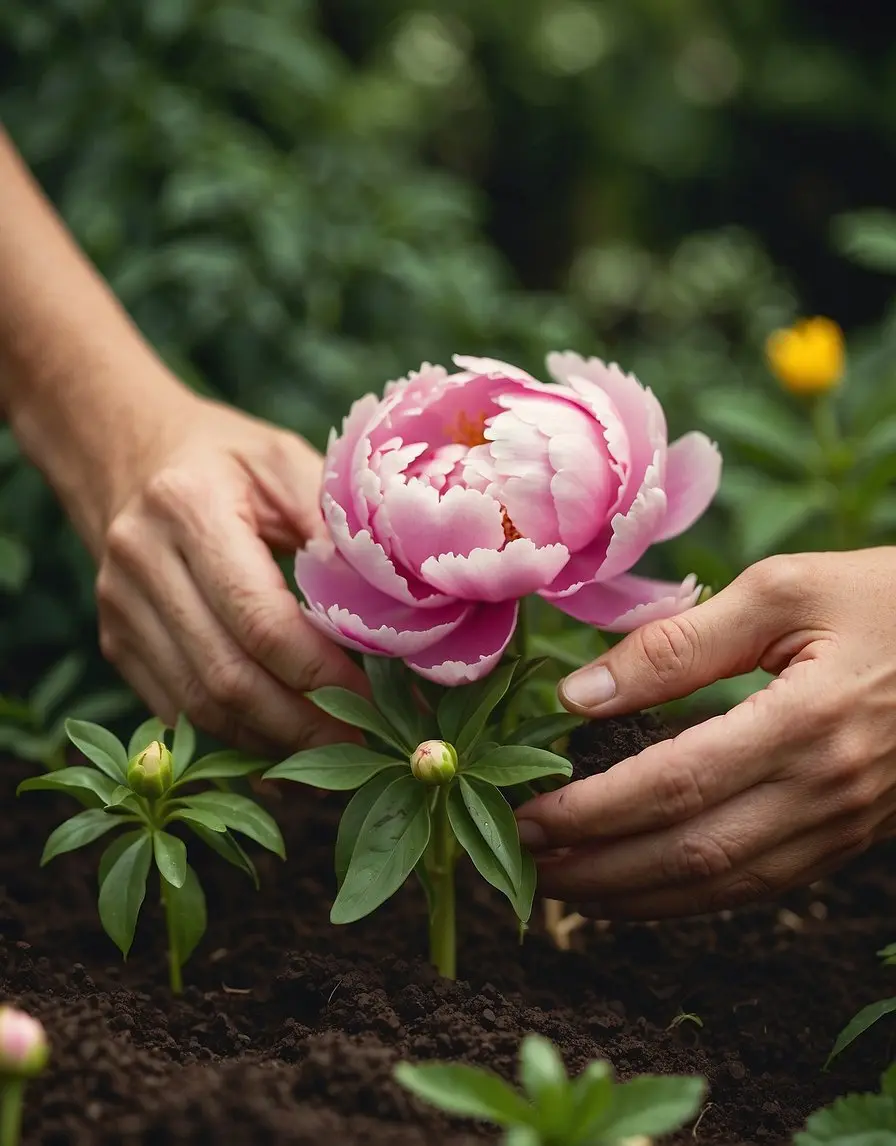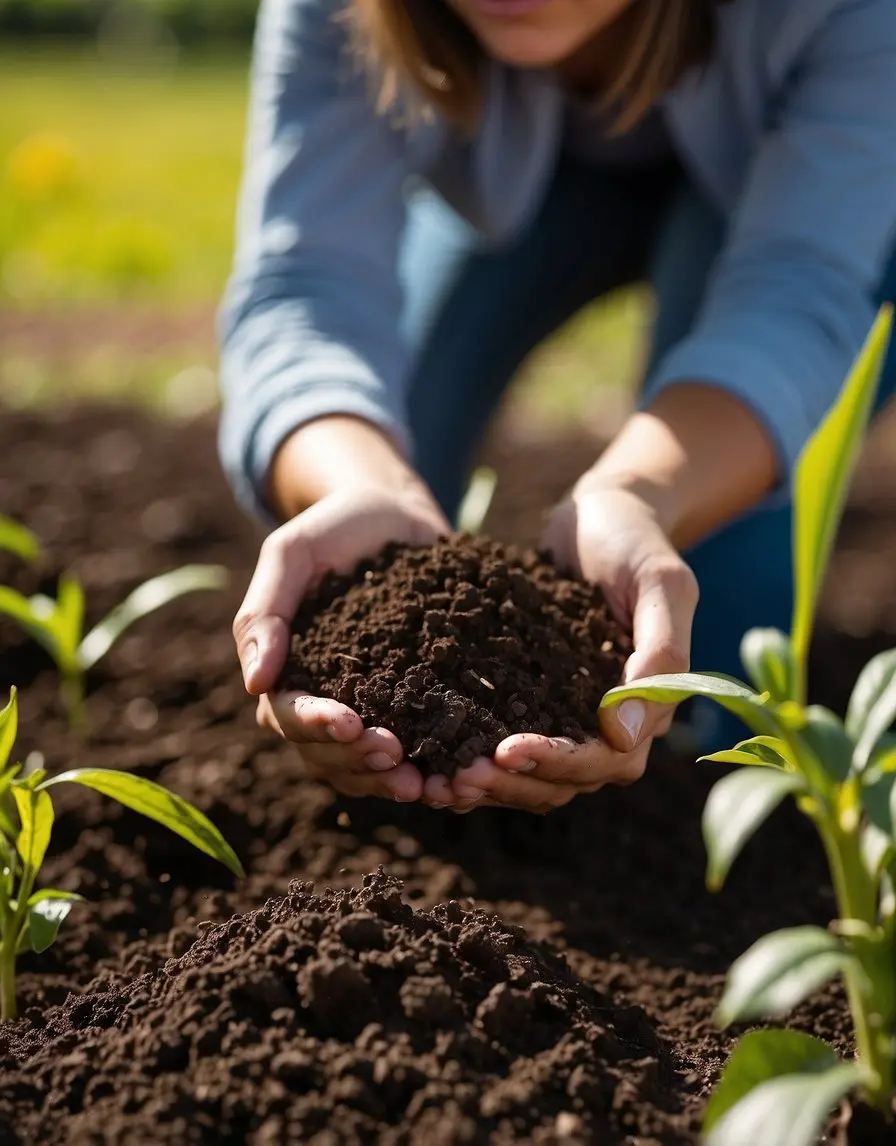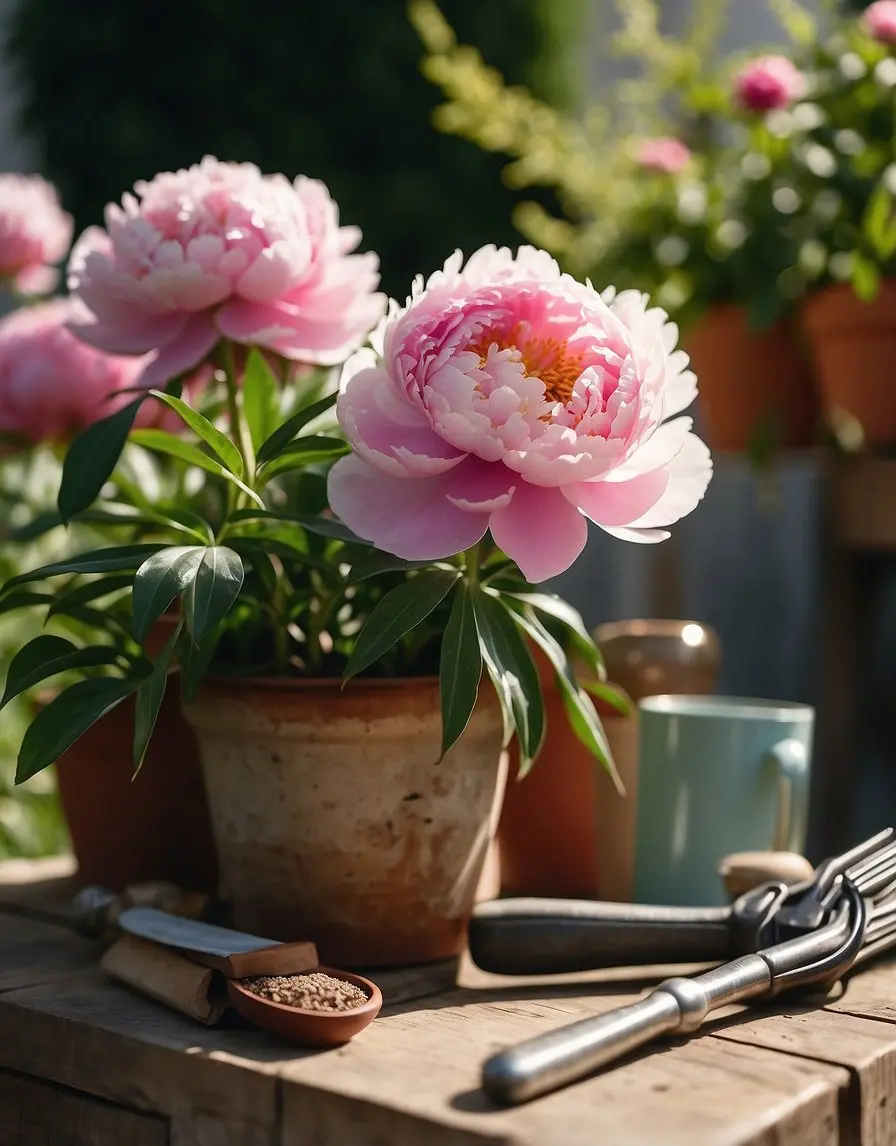Are you dreaming of a garden filled with lush, vibrant peonies? These stunning flowers can transform any outdoor space into a picturesque paradise.
In this post, we’ll share easy tips to help you grow peonies that will leave your neighbors in awe.
Whether you’re a seasoned gardener or a beginner, our guide will make cultivating these beauties a breeze.
Let’s get started on creating your own stunning garden!

Understanding Peonies
Peonies are beautiful, long-lived perennials that can thrive in your garden with the right care. They are known for their large, showy blooms and come in a variety of colors, such as pink, white, red, and yellow.

Key Attributes of Peonies
| Attribute | Description |
|---|---|
| Type | Perennial |
| Bloom Time | Late spring to early summer |
| Light | Full sun (6-8 hours) |
| Soil | Well-draining, rich in organic matter |
| Water | Moderate, avoid waterlogging |
| Hardiness Zones | 3-8 (USDA) |
Choosing the Right Peonies
To grow strong and beautiful peonies, you need to pick the right types and top-quality tubers. This will set the foundation for healthy plants and stunning blooms.
Types of Peonies
| Type | Description |
|---|---|
| Single | Features a single or double row of petals surrounding a cluster of stamens. |
| Japanese | Has a single or double row of petals with a cluster of modified stamens (staminodes) in the center. |
| Anemone | Similar to Japanese but with a more pronounced cluster of staminodes, giving a fluffy appearance. |
| Semi-double | Multiple rows of petals with visible stamens, providing a fuller look than singles. |
| Bomb | Inner petals form a dense, rounded cluster, surrounded by a single or double row of guard petals. |
| Full Double | Numerous rows of petals with no visible stamens, creating a lush, dense bloom. |
These types offer a variety of aesthetic options for gardeners looking to enhance their landscapes with peonies.
Site and Soil Preparation

Growing peonies successfully requires well-drained soil and a sunny spot. You’ll also need to ensure the soil has the right pH level and essential nutrients for optimal growth.
Location Selection
Choose a spot that gets at least 6 hours of direct sunlight daily. Peonies love the sun, and more light means better blooms.
Avoid areas where water tends to pool or stay soggy, as peonies don’t like wet feet. A location with good airflow will help prevent diseases.
Shelter the plants from strong winds by placing them near a fence or building. This will protect the delicate blooms from damage.
If you’re planting multiple peonies, space them about 3 feet apart to give them room to grow.
Preparing the Soil
Start with removing any weeds, rocks, or debris from the planting area. This ensures the soil is clean and free of obstacles.
Then, till the soil to a depth of 12-18 inches, which allows the roots to penetrate easily.
Add a 4-inch layer of organic matter, like compost, worm castings, or well-rotted manure. This improves soil fertility and drainage.
Afterward, mix the organic matter thoroughly into the soil. This rich mixture provides peonies with the necessary nutrients and a good foundation for growth.
pH and Nutrients
Peonies thrive in soil with a pH of 6.5 to 7, mildly acidic to neutral. Test the soil using a pH testing kit, which you can find at garden centers.
If the pH is too low (acidic), add lime to raise it. If it’s too high (alkaline), sulfur can lower it.
For nutrients, peonies benefit from a fertilizer high in phosphorus and potassium. An NPK ratio like 5-10-10 or 10-20-20 is ideal.
Apply fertilizer when the shoots are a few inches high. This will promote healthy growth and plentiful blooms.
Planting Your Peonies
To ensure your peonies thrive, focus on the right timing, proper depth, and adequate spacing. These factors are key to establishing healthy, blooming plants.
Planting Time
The best time to plant peonies is in the fall, typically between late September and early November. This allows them to establish roots before winter.
You can also plant them in early spring, but fall is preferable.
Peonies need time to settle into their new environment. They use the cooler months to develop strong roots.
Aim to plant your peonies six weeks before the ground freezes, giving them a head start for spring growth.
Planting Depth
Proper planting depth is crucial for peony growth.
Place the peony tubers so that the buds, or “eyes,” are no more than 2 inches below the soil surface. If planted too deeply, peonies might not bloom.
Use a sharp spade to dig a hole wide enough to accommodate the roots without crowding them.
Then, cover the buds lightly with soil. Overly deep planting can lead to poor growth and flowering issues.
Spacing Considerations
Peonies need space to spread out. When planting multiple peonies, space them about 3 to 4 feet apart.
This allows each plant access to resources and ensures good air circulation, reducing the risk of disease.
If you’re planting near other plants or structures, ensure there’s enough room for the peonies to grow. Crowded conditions can lead to poor air circulation and increased susceptibility to fungal diseases.
Caring for Peonies
Peonies need proper care to thrive and produce beautiful blooms. Key factors include watering, fertilizing, sunlight, soil, and mulching.
Watering Requirements
Peonies need regular watering, especially during dry periods. Make sure to water deeply to encourage strong root growth.
Young plants require more frequent watering, about 1 inch per week, while established plants are a bit more drought-tolerant.
Avoid overhead watering as it can lead to fungal issues. Instead, water at the base of the plant.
Proper drainage is crucial to prevent root rot, so ensure the soil does not become waterlogged.
Fertilizing Requirements
Fertilizing peonies helps them grow strong and flower abundantly.
Use a balanced fertilizer, ideally with a higher phosphorus and potassium ratio like 5-10-10 or 10-20-20.
Apply fertilizer in early spring when new shoots emerge.
Established peonies benefit from a light application of compost or aged manure in the fall.
Over-fertilizing can harm the plants, so follow label instructions carefully.
Sunlight Requirements
Peonies thrive in full sun, needing at least 6 hours of direct sunlight each day.
In very hot climates, some afternoon shade can help prevent the blooms from wilting.
Sunlight affects blooming; insufficient light will result in fewer flowers. Planting peonies in a spot with plenty of sunlight ensures the best growth and bloom production.
Soil Requirements
Peonies prefer well-draining soil with a neutral to slightly acidic pH (6.5-7.0).
Heavy clay soils can be improved by adding compost or organic matter to enhance drainage and soil structure.
When planting, ensure the peony roots are just 2 inches below the soil surface. Planting too deep can hinder blooming.
Consistently check soil moisture levels to avoid waterlogging.
Mulching
Mulching helps retain soil moisture, suppress weeds, and protect peony roots from temperature extremes.
Use organic mulch like shredded bark, straw, or compost, applying a 2-3 inch layer around the base of the plant without covering the crown.
In winter, mulch provides extra protection against frost. Remove excess mulch in spring to prevent it from affecting new growth and to reduce the risk of fungal diseases.
Propagation and Division
To expand your peony collection, you can propagate them through division or other methods. Each method has its own steps and benefits.
Dividing Peonies
When dividing peonies, you typically start with a mature plant. Use a clean, sharp knife to dig up the plant and cut the roots. Aim to have each division with 2-3 healthy eyes (buds) and some supporting roots.
Cut the roots back to about 6 inches from the crown. Each piece should have at least one crown bud since this is essential for new growth.
Plant the divisions in well-draining soil, spacing them about 3 feet apart. Water them well after planting.
Propagation Methods
Peonies can also be propagated from seeds or root cuttings.
Seeds:
Wait until the seed pods turn brown and leathery, then cut them from the plant. Remove the seeds and plant them in pots or directly in the garden. It might take several years for these peonies to bloom.
Root Cuttings:
Cuttings should be taken from the root section below the crown. They need to be placed in a sunny, well-drained spot. Ensure that each cutting has at least one eye and some root tissue for successful growth.
Winter Care and Maintenance
When winter arrives, your peonies will need some extra attention. The plants die back, and you’ll see new growth come spring.
Cleanup:
Once the foliage dies, cut it down to the ground. Rake up any debris around the base to prevent fungal disease.
Chilling Hours:
Peonies need chilling hours, typically 500 to 1,000 hours of temperatures between 32 and 40°F. This helps them bloom in spring.
Mulching:
Mulching isn’t always needed but can be beneficial. Apply an inch or two of straw or shredded bark, especially for the plant’s first winter.
Protection:
If you’re in a very cold zone, like Zone 3, extra mulch can provide needed insulation. For milder zones, simply cleaning up and a light mulch layer is sufficient.
Additional Secret Tips For Better Blooms and Growing Peonies
Swap Outwater Regularly
Although peonies love deep drinks of water, make sure not to over-water them. New plants need water every 5-7 days, while established ones need it every 10-14 days. Keep the soil moist, but never soggy.
Proper Lighting is Key
Peonies thrive with 6-8 hours of full sun daily. However, they can also do well with morning sun and light afternoon shade. Avoid planting them in full shade because they won’t bloom well.
Rich, Well-Drained Soil Matters
Ensure your soil is rich and loamy. Peonies prefer well-drained soil that isn’t waterlogged. Mixing compost or aged manure can improve soil quality, providing nutrients that help peonies grow strong and healthy.
Use the Right Fertilizer
Use a fertilizer higher in phosphorus and potassium like a 5-10-10 or 10-20-20 blend. This strengthens their growth and promotes better blooms. Apply fertilizer when shoots are a few inches tall.
Division for Healthy Plants
Every few years, divide your peonies to keep them healthy. Dig out at least 2 feet from the plant to minimize root damage. Cut tubers into sections, ensuring each piece has at least 5 buds.
Support During Growth
As peonies grow, they can become top-heavy and may need stakes or cages to support their stems. Position these supports early in the growing season to help keep the stems and flowers upright.
Mulching for Moisture
Use mulch to help retain moisture and keep the roots cool. Mulch also controls weeds, which compete with peonies for nutrients. Use organic mulch like wood chips or straw, and apply a layer 2-3 inches thick around the base of the plant.
Troubleshooting Common Issues

Peonies can face problems related to pests, diseases, and environmental factors. Knowing how to address these issues will help keep your plants healthy and thriving.
Certainly! Here are detailed tables for each of the sections mentioned in your post about growing peonies:
Pest Management
| Pest | Description | Control Method |
|---|---|---|
| Aphids | Small, green or black insects that cluster on new growth, sucking sap from the plant. | – Spray with a strong stream of water – Use insecticidal soap |
| Ants | Attracted to the sugary sap on peony buds but don’t harm the plant. | – Apply a barrier of diatomaceous earth around the base of the plant |
| Thrips | Tiny, slender insects that feed on plant sap, causing damage to flowers and leaves. | – Apply neem oil early in the morning or late in the evening |
| Spider Mites | Small arachnids that cause stippling and discoloration on leaves. | – Apply neem oil early in the morning or late in the evening |
Disease Prevention
| Disease | Symptoms | Control Method |
|---|---|---|
| Powdery Mildew | White powder on leaves | – Water at the base of the plant in the morning – Avoid wetting foliage – Remove affected leaves – Apply fungicide if needed |
| Botrytis Blight | Buds turn brown and mushy | – Remove and destroy infected plant parts – Cut back peonies to the ground in the fall – Dispose of debris to prevent overwintering |
| Peony Leaf Blotch | Purplish-brown spots on leaves and stems | – Improve air circulation by spacing plants properly – Remove affected leaves |
Environmental Stress
| Stress Factor | Description | Management Strategy |
|---|---|---|
| Sunlight | Peonies prefer full sun with 6-8 hours of sunlight. | – Move peonies to a sunnier spot if they are in partial shade |
| Water Stress | Peonies need deep, infrequent watering. | – Ensure soil drains well to prevent root rot – Mulch to retain soil moisture and reduce weeds |
| Extreme Temperatures | Hot or cold conditions can cause stress. | – Provide afternoon shade in hot climates – Use |
